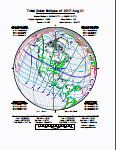![]()
- - text and links as of last publication - -
| CAUTION! OBSERVING A SUN ECLIPSE IS DANGEROUS AND MAY CAUSE IRREVERSIBLE EYE DAMAGE, UP TO BLINDNESS, ANNULAR AND PARTIAL ECLIPSES INCLUDED! Observing a Sun eclipse necessitates DEDICATED SAFE TECHNIQUES! |
That second solar eclipse in 2017 -- and the last major astronomical event for the year -- is a total solar eclipse occurring on August 21st, 2017. A total solar eclipse occurs when the Sun, along a certain path, may be seen entirely occulted by the Moon's disk, leading to the much famed show of the solar corona streaming away from the occulted disk of the Sun at greatest. Anywhere in the area of a partial solar eclipse, observers are treated with a Sun indented by the dark disk of the Moon. for more about solar eclipses, theoretically, see our tutorial "Sun Eclipses". The total solar eclipse of August 21st, 2017 is occurring from in the northern central Pacific ocean down to the central eastern Atlantic ocean. In the U.S.A., the total solar eclipse of August 21st, 2017 is one of the most anticipated astronomical events in decades as it is the first total eclipse visible from America’s lower 48 states in over 38 years (the last one had occurred in 1979). The U.S. eclipse is also one which will run over a large uninterrupted land mass. The eclipse centrality is beginning far South of Alaska, in the Pacific Ocean as it then runs 28 minute over the ocean before reaching the continental U.S.A in the state of Oregon. It will then cross a diagonal in the country down to the state of South Carolina (inhabitants willing to a more detailed view of where the eclipse is seen along the way will usefully check that additional map as the American Astronomical Society features a section dedicated to that U.S. solar eclipse. August 21st, 2017 is a Monday). The eclipse then is journeying over the Atlantic ocean during 75 minute until it ends over it, southwest of Senegal. Eclipse's path width is at 71.3 miles (114.7 kilometers). As the greatest eclipse occurs over the state of Kentucky by 18:25:32 UT the Sun will be lying then at a 64 degree of altitude and the eclipse lasting 2 minutes 40.1 seconds. Like usual, a partial solar eclipse is seen either side of the line of centrality, from Alaska and Greenland down to northern Peru and Brazil. Hawai also is concerned. The closer the centrality line, the more indented the Sun like for the remaining of the U.S.A. and Canada, wich really makes the eclipse a one of interest! Countries and areas either side beyond are concerned by a lesser partial eclipse. The background of the total eclipse is in southwestern Leo, the Lion, close to Regulus the main star to the constellation (which adds to the interest of the eclipse too). Mars and Mercury will also be revealed by the totality
 | A illustration of how a partial eclipse looks like either side of a total or annular; numbers match the one found on a eclipse's chart |
Eclipse's main data are the following (data as of November 2016). The Moon's apparent diameter will be of 32' 6.8", compared to the Sun's 31' 37.4". Greatest eclipse
occurs in the state of Kentucky, in the U.S.A., at 18:25:31.5 UT, the duration is 02m40.1s and the Sun 63.9 degree above the horizon. for more about how to observe a solar eclipse, see our tutorial 'Observing a Sun Eclipse':
- greatest eclipse: 18:25:31.5 UT
- eclipse magnitude (fraction of the Sun's diameter obscured by the Moon at greatest eclipse): 1.0306
- U1 to U4 (moments of first-last external-internal tangency of the umbra with Earth's limb; practically these are the moments of the eclipse for the places where the eclipse is total); in UT: U1 at 16:48:35.7, U2 at 16:49:35.8, U3 at 20:01:39.3, U4 at 20:02:34.0
- P1 to P4 (moments of first-last external-internal tangency of the penumbra with Earth's limb; practically these are the moments of the eclipse for the places where the eclipse is partial), in UT: P1 at 15:46:51.1, P2 at 18:11:56.8, P3 at 18:39:24.6, P4 at 21:04:23.1
 | see a .PDF map for the total solar eclipse of August 21st, 2017. map courtesy Fred Espenak |
. for more about this eclipse and for more about solar and lunar eclipses generally, you may see at the Internet, with Fred Espenak a reference in the domain
Website Manager: G. Guichard, site 'Amateur Astronomy,' http://stars5.6te.net. Page Editor: G. Guichard. last edited: 1/1/2017. contact us at geguicha@outlook.com